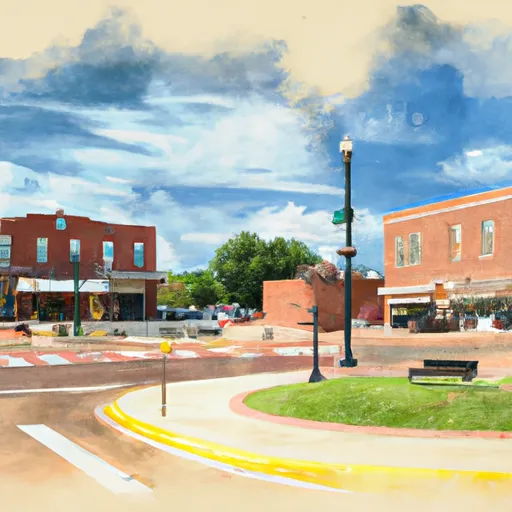-
 Snoflo Premium
Snoflo Premium
Get unlimited access to all our content
With no Ad interruptions! - Start Your Free Trial Login with existing account
Macomb
Eden Index
Climate
8.3
•
Recreation
2.2
•
Community
1.5
•
Safeguard
4.4/10

Macomb, Oklahoma is a small rural community located in Pottawatomie County. The town experiences a humid subtropical climate, characterized by hot, humid summers and mild winters. Summers in Macomb are typically hot, with temperatures often reaching the mid-90s Fahrenheit, while winters are cooler with temperatures in the 40s and 50s.
Hydrologically, Macomb is situated near the banks of the North Canadian River. This river is a vital water source for the area, providing opportunities for fishing and boating. The river also offers scenic views and is a popular spot for outdoor enthusiasts.
Outdoor recreation in Macomb is abundant, with several opportunities for activities such as hiking, camping, and hunting. The nearby Shawnee Twin Lakes and Lake Thunderbird State Park provide excellent fishing and boating opportunities. Additionally, the area is home to numerous parks and trails, allowing residents and visitors to enjoy nature and engage in outdoor activities.
In conclusion, Macomb, Oklahoma offers a diverse climate, access to the North Canadian River, and a variety of outdoor recreation opportunities, making it an attractive destination for nature enthusiasts.
What is the Eden Index?
The Snoflo Eden Index serves as a comprehensive rating system for regions, evaluating their desirability through a holistic assessment of climate health, outdoor recreation opportunities, and natural disaster risk, acknowledging the profound impact of these factors on livability and well-being.
Climate Health Indicator (CHI): 8.3
Macomb receives approximately
964mm of rain per year,
with humidity levels near 83%
and air temperatures averaging around
17°C.
Macomb has a plant hardyness factor of
7, meaning
plants and agriculture in this region tend to thrive during the non-winter months.
By considering the ideal temperature range, reliable water supplies, clean air, and stable seasonal rain or snowpacks, the Climate Health Indicator (CHI) underscores the significance of a healthy climate as the foundation for quality living.
A healthy climate is paramount for ensuring a high quality of life and livability in a region, fostering both physical well-being and environmental harmony. This can be characterized by ideal temperatures, reliable access to water supplies, clean air, and consistent seasonal rain or snowpacks.
Weather Forecast
Streamflow Conditions
Lower Canadian
Area Rivers
Lower Canadian
Snowpack Depths
Lower Canadian
Reservoir Storage Capacity
Lower Canadian
Groundwater Levels
Recreational Opportunity Index (ROI): 2.2
The Recreational Opportunity Index (ROI) recognizes the value of outdoor recreational options, such as parks, hiking trails, camping sites, and fishing spots, while acknowledging that climate plays a pivotal role in ensuring the comfort and consistency of these experiences.
Access to outdoor recreational opportunities, encompassing activities such as parks, hiking, camping, and fishing, is crucial for overall well-being, and the climate plays a pivotal role in enabling and enhancing these experiences, ensuring that individuals can engage in nature-based activities comfortably and consistently.
Camping Areas
| Campground | Campsites | Reservations | Toilets | Showers | Elevation |
|---|---|---|---|---|---|
| Texoma Marina | None | 651 ft | |||
| Isle du Bois - Roberts Lake State Park | 182 | 685 ft | |||
| Sheppard AFB Military - Lake Texoma | None | 657 ft | |||
| Lebanon - Lake Texoma | None | 617 ft | |||
| Johnson Branch - Roberts Lake State Park | 163 | 685 ft | |||
| Juniper Point - Lake Texoma | None | 655 ft | |||
| Cedar Bayou Marina - Lake Texoma | None | 647 ft | |||
| Brier Creek - Lake Texoma | None | 656 ft | |||
| Walnut Creek Resort | 25 | 650 ft | |||
| Buncombe Creek - Lake Texoma | None | 659 ft |
Nearby Fishing
Catastrophe Safeguard Index (CSI):
The Catastrophe Safeguard Index (CSI) recognizes that natural disaster risk, encompassing floods, fires, hurricanes, and tornadoes, can drastically affect safety and the overall appeal of an area.
The level of natural disaster risk in a region significantly affects safety and the overall livability, with climate change amplifying these risks by potentially increasing the frequency and intensity of events like floods, fires, hurricanes, and tornadoes, thereby posing substantial challenges to community resilience and well-being.
Community Resilience Indicator (CRI): 1.5
The Community Resilience Indicator (CRI) recognizes that education, healthcare, and socioeconomics are crucial to the well-being of a region. The CRI acknowledges the profound impact of these elements on residents' overall quality of life. By evaluating educational resources, healthcare accessibility, and economic inclusivity, the index captures the essential aspects that contribute to a thriving community, fostering resident satisfaction, equity, and social cohesion.

